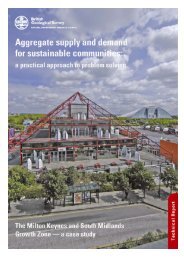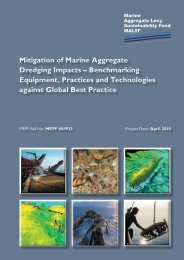creating environmental improvements through biodiversity
creating environmental improvements through biodiversity
creating environmental improvements through biodiversity
Create successful ePaper yourself
Turn your PDF publications into a flip-book with our unique Google optimized e-Paper software.
Many site BAPs would benefit from incorporating fewer habitat types in restoration designs, and ensuring<br />
that larger areas of valuable habitat are created. Restoration plans should include measurable biological aims<br />
and ecologically meaningful designs.<br />
Information on habitat creation / restoration design should be disseminated more widely among planners and<br />
between disciplines (e.g. ecologists, geologists and hydrologists).<br />
Monitoring of <strong>biodiversity</strong> on planned, active and restored minerals sites should be standardised and<br />
recorded centrally.<br />
Further investigation would be useful into preservation of best and most versatile agricultural soils on sites<br />
with a nature conservation end-use, and the role of important wildlife habitats as carbon stores.<br />
Restorations in air safeguarding zones should be considered on a site-by-site basis, with relation to the most<br />
hazardous species locally. Site design and restoration in air safeguarding zones should be researched further<br />
in relation to bird strike risk.<br />
Sustainable Aggregates Creating Environmental Improvements <strong>through</strong> Biodiversity<br />
6.5 LONG-TERM MANAGEMENT OF SITES:<br />
Long-term management of sites and financial provision for this are key perceived blocks to habitat creation<br />
on minerals sites. Integration of long-term management into site management plans is key to addressing<br />
these issues.<br />
Existing mechanisms can be used to secure long-term management, including section 106 agreements and<br />
‘official’ provision for transfer of management. Long-term management agreements for valuable sites that run<br />
beyond a 5-year period can be very beneficial.<br />
A commercial approach to funding long-term conservation management can prove very useful, and can<br />
even integrate by-products of management into commercial schemes. High quality after-care of sites can<br />
sometimes help to reduce overall long-term management costs.<br />
Other end-uses can be integrated with nature conservation restoration if considered and planned early, but<br />
should not be detrimental to the quality of habitat provided.<br />
Long-term monitoring is important on restored sites, and should feed back into site management. Due to the<br />
specific characteristics of minerals sites, monitoring and management needs may be complicated. Therefore<br />
communication and data sharing among the minerals community is especially important.<br />
6.6 WORKING TOGETHER:<br />
The value of stakeholder engagement at an early stage is a common theme among many of the reviewed<br />
reports. In many cases ALSF funding has brought all types of stakeholders together for the first time.<br />
Integration of end-use demands can be a successful means of providing for long-term management. Part of<br />
successful integration is the sharing of expertise and provision of contacts among different disciplines.<br />
37

















